I was at Supercuts when that song came on.
You know which one. It involves a horse.
“Oh no, not this song again,” my stylist bemoaned. “First it was all over Tik Tok. Then everyone was playing it on their Spotify. Now, even the radio is playing it!”
There it was.
“Even the radio is playing it”.
Music journalists and fanatics alike have asserted that songs don’t receive significant airplay on FM radio until weeks after they’ve already been exposed on Spotify. Now, this perception wasn’t limited to music snobs. Even everyday listeners like my hair stylist are saying it.
Is it true?
We’ve examined the Top 200 most-streamed songs on Spotify from January through August 2019 to find out what radio can learn from Spotify. Today, we’ll compare Spotify to data from the Nielsen-BDS powered Billboard Radio Songs chart during the same period to see if radio really is behind the curve.
To set the framework for how to answer this question objectively, let’s briefly recap what we discovered in our post Is Spotify Replacing Record Stores or Radio Stations:
- On Spotify, the biggest songs often receive the most plays the week they’re released, as an artist’s core fans check out their latest project, or as curious music fans simply sample what everyone’s talking about. This pattern is the same pattern music sales have exhibited for decades.
- On the radio—whose audience is broader than an artist’s die-hard fans—it typically takes weeks for listeners to get to know and warm up to new songs.
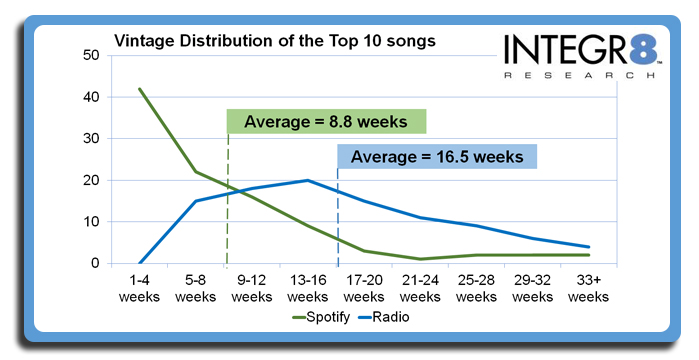
Because of this fundamentally different usage pattern, the average vintage of a Top 10 song on Spotify is under nine weeks, while the average vintage of a top 10 song on the radio is over 16 weeks. Therefore, if we’re simply going to compare what’s #1 on Spotify to what’s in radio’s power rotations, radio is going to inherently appear late to the party.
A better way to approach this question is to examine if radio starts exposing a song when it first makes a splash on Spotify—and if radio exposes songs often enough for the song to reach peak airplay on radio within a typical timeframe.
With these two criteria in mind, let’s dive in to some of 2019’s biggest hits:
When Radio Adds a Song at the Start
A prime example of the expected pattern is Ariana Grande’s “7 Rings”.
- Spotify users flocked to listen to the track the week it debuted; the same week radio programmers flocked to add it into rotation.
- By the song’s 3rd week, it was already among the Top 10 songs on U.S. radio. The song reached peak airplay by week #11, several weeks ahead of schedule for the typical title.
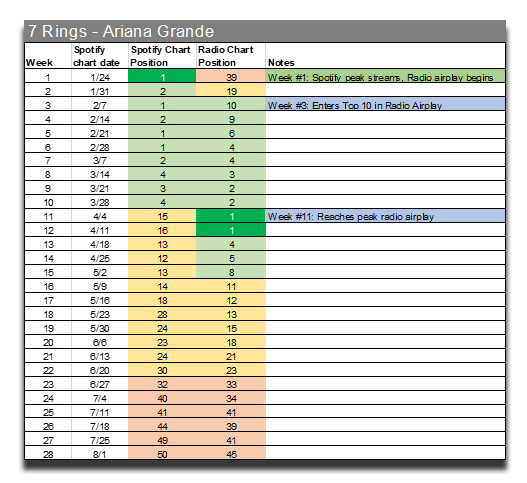
Jonas Brothers’ “Sucker” also followed this pattern of debuting big on Spotify and growing quickly on radio.
- It went Top 10 in radio airplay by week #5 and peaked at #1 in radio airplay by only week #7.
- While Spotify streams declined each week as they typically do for many big songs that debut #1, “Sucker” remained among Spotify’s Top 30 for a healthy 17 weeks, coinciding with the song’s peak radio exposure.

When Radio Generates Greater Spotify Streaming
As we noted in our previous post, not all songs follow the pattern of debuting big. Some songs work their way up week by week on Spotify just as they typically do on radio.
Country songs frequently follow this pattern. Country doesn’t yet garner nearly as much usage on streaming platforms as it does radio airplay, for reasons we spotlighted in Why Country is Missing from Streaming.
Consider Morgan Wallen’s “Whiskey Glasses”:
- Airplay started at the same time as it started charting on Spotify.
- Both airplay and Spotify plays grew in unison.
- “Whiskey Glasses” reached its airplay peak in week #11, followed later by its Spotify streaming peak two weeks later.
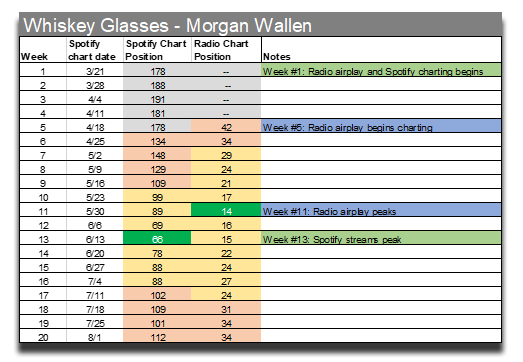
For these songs, hearing them on the radio arguably bolstered listeners’ interest in playing them again on Spotify. These examples demonstrate that the traditional model of radio exposure generating label and artist revenue is still relevant in the era of streaming.
When radio hangs on too long
There are cases when radio is quick to embrace a new song, but hangs on to that song after Spotify users have already rejected it en masse.
A prime example is Taylor Swift’s “ME!”
- Radio eagerly added the song as one would expect from Swift: “ME!” was Top 30 in airplay in its debut week and among the Top 10 in radio exposure by week #3.
- Also as expected, “ME!” debuted #1 on Spotify, but after only two more weeks, the song fell from #8 to #26.
- After only five weeks, “ME!” was out of Spotify’s Top 30 songs, while many U.S. stations were still powering it.
Radio didn’t start backing off “ME!” until the song’s Spotify stream count fell unusually fast for a month.
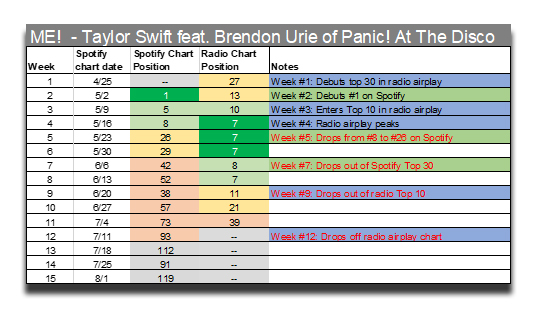
Some stations likely didn’t believe Swift could really have a stiff until the callout never improved. However, examining how quickly Spotify users abandoned the song compared to bona fide pop hits could have given radio an earlier indication that it was time to move on from “ME!”
When radio is late to the party
Finally, there is evidence that radio was arguably late to embrace some of 2019’s biggest hits, particularly songs that first became hits online.
Billie Eilish “Bad Guy” dropped in April and instantly become Spotify’s most-streamed song in the U.S. that week.
- Although the song did receive smatterings of airplay in April, “Bad Guy” finally began receiving enough airplay to be among the Top 50 most played songs on U.S. radio in late May. At that point, “Bad Guy” had already remained in Spotify’s Top 3 for an impressive eight weeks.
- In July, the remix with Justin Bieber dropped, bolstering Spotify plays.
- Finally in mid-August, radio airplay peaked for “Bad Guy”, 20 weeks after the song debuted at #1 on Spotify.
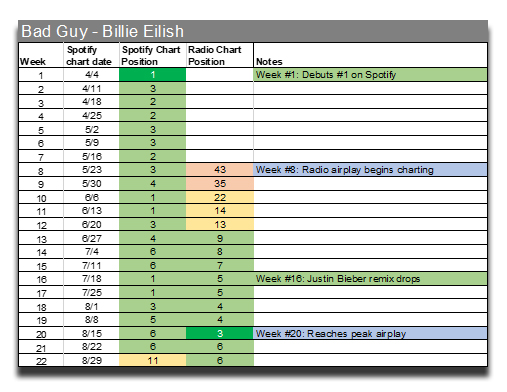
Then there’s the slow and symbiotic development on both Spotify and radio of Lizzo’s “Truth Hurts”. Like Lizzo herself, “Truth Hurts” crept its way up on Spotify after being a cult favorite.
- While some radio stations did pick up on the song around the time it became a Top 10 song on Spotify, it didn’t receive significant radio exposure for another six weeks.
- At this point, “Truth Hurts” already appeared to have peaked on Spotify. However, the song’s new radio exposure appears to have contributed to a second round of streaming growth for “Truth Hurts”. It reached peak streaming 15 weeks after first appearing on Spotify’s Top 200 chart.
- “Truth Hurts” wouldn’t reach peak radio exposure until week #21.
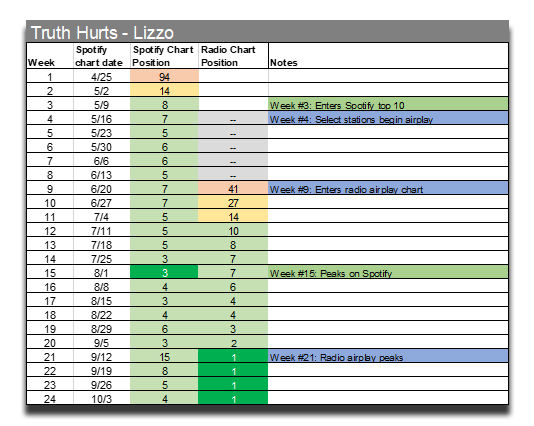
With all the buzz around Eilish and Lizzo, it would be easy to examine these discrepancies between streaming and airplay and assume radio is simply out of touch.
That assertion is neither accurate nor complete.
Billie Eilish and Lizzo both have rabidly passionate fans. However, their songs were unusually polarizing among the broader radio audience when they first heard them. Both “Bad Guy” and “Truth Hurts” simply don’t sound quite like any songs that came before. While many listeners did passionately love these songs from the start, a comparable number of listeners initially flat out hated them.
That leaves programmers with the dilemma of whether playing a buzzworthy act with a passionate fan base is worth alienating those listeners “who don’t get it”. Unlike streaming, haters hurt radio—they tune out your station today. However, depending on what listeners expect from you, failing to play songs that elicit passion and represent the Zeitgeist can also hurt radio—fewer listeners tune in tomorrow.
As you’re debating whether or not you’re willing to take that gamble, consider that there’s another interpretation to my hair stylists’ comment, “even the radio is playing it”, than assuming she thinks radio is last to play new songs.
Her comment might instead reflect a perception that, once a song is on the radio, it truly is a mass-appeal phenomenon.
The Takeaway for Radio: Rest assured the pundits who claim radio is way behind streaming don’t understand how music consumption patterns differ on each platform. For most songs, radio is, in fact, right on time. In these times of changing tastes, however, you will have to carefully weigh both the impact on listenership and on your brand when your listeners have mixed reactions to songs that blow up on Spotify.

ANNOUNCING “WHAT RADIO CAN LEARN FROM SPOTIFY” WEBINAR
Join us Wednesday, November 13th at 2:00 EST / 11:00 PST for our in-depth analysis of Spotify listening behavior and what lessons it holds for radio programmers. In the webinar, we’ll examine:
- What are the different consumption patterns for new music on Spotify—and how radio can use those patterns to spot real hits.
- When should radio start—and stop—playing songs.
- Why Spotify is replacing record stores more than radio stations—and why it matters for how radio programmers interpret Spotify data
- How new releases have a major impact on music consumption that’s often ignored by radio.

